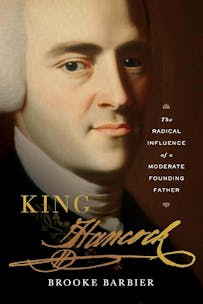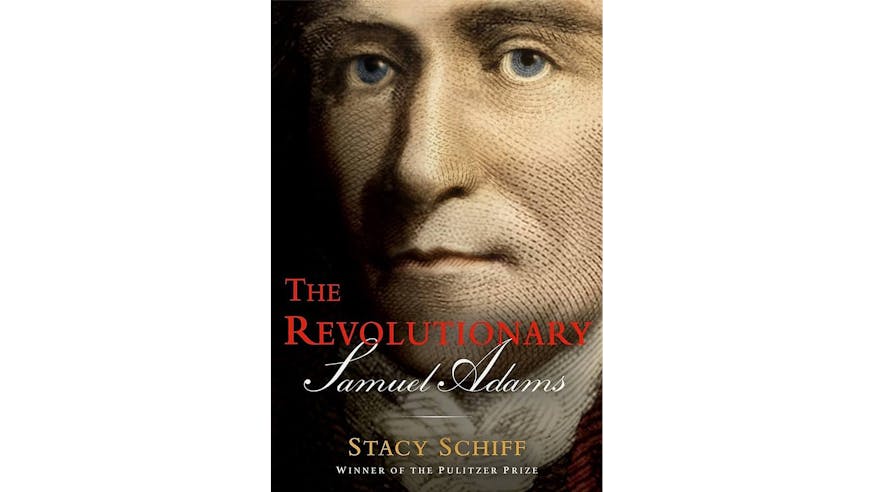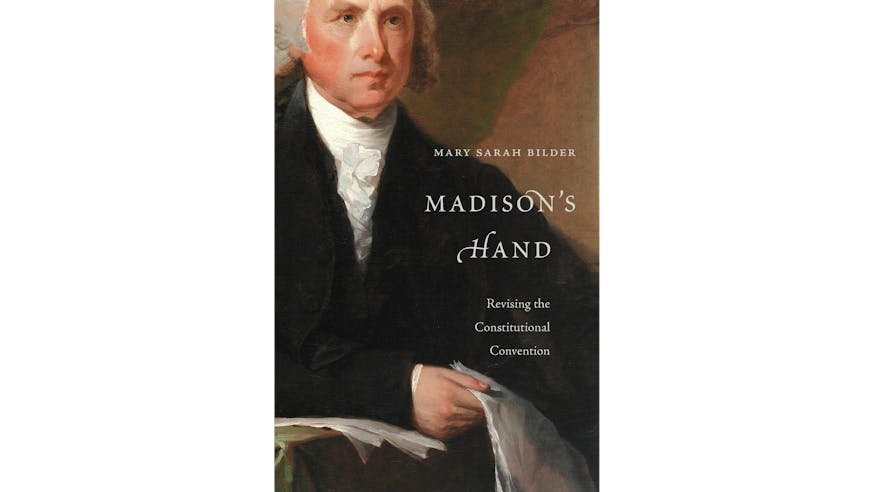Read the Revolution
King Hancock
April 10, 2024
Purchase the book from Harvard University Press.
The most famous signature in American history belongs to a man whose politics are not widely known. John Hancock’s bold signature on the Declaration of Independence might suggest his radicalism, but, in truth, Hancock positioned himself as a moderate American Revolutionary. The newest biography about Hancock shares the story of his rise to power and popularity.
In King Hancock: The Radical Influence of a Moderate Founding Father, historian Brooke Barbier describes Hancock as a man who “craved people’s affection.” He succeeded in wielding influence — be it as President of the Continental Congress or Governor of Massachusetts — by taking the middle ground. Hancock could see merits on both sides of a debate. He was not outspoken. This helped him, despite his wealth, appeal to a broad range of people, notably farmers and laborers in Massachusetts. His philanthropy helped his popularity. According to Barbier, “One way Hancock had gained such popularity over the years was his skill at getting ordinary people on his side. Buying dinners, accepting worthless paper currency on debts, and pardoning rebels all contributed to this. But he was also able to connect personally and meaningfully with people far beneath him in the social hierarchy.” Hancock used his appeal quite effectively as Governor of Massachusetts in the 1780s and 1790s, a turbulent period in the state’s history.
Read an excerpt in which Barbier describes John Hancock’s decision to step away from the Continental Congress in 1777-1778 and return to Massachusetts due to his poor health, an issue that afflicted not only his body but also his political career.
Excerpt
"My constant application to Publick Business both in & out of Congress, has so impair'd my Health, that some Relaxation has become absolutely necessary," Hancock wrote to Thomas Jefferson in the fall of 1777. Hancock had been going so hard for so long as president that he finally hit a wall. "I am wore down," he explained. He announced to Congress in October that he was returning to Boston for a time to tend his health and "my own Private Affairs." Hancock did not know it, but he was leaving the highest political office in which he would ever serve.
Hancock departed right before two monumental events for the nascent United States. The first was the news of General John Burgoyne's surrender in Saratoga. Supplied with arms and ammunition from the French, the Continental Army overpowered British forces. Burgoyne's defeat was so devastating that Hancock used the office name as a synonym for a sound thrashing. "If we can Burgoyne this Army it will be a fine Affair," he wrote months after Saratoga. After this decisive victory, France decided to formally help the effort, even as Spain remained reluctant. No longer would France simply provide supplies; they were also going to send troops and their navy. Hancock would come to play a key role in nurturing tenuous alliance.
The departing president would also miss Congress finalizing the Articles of Confederation. The effort to write them began in the summer of 1776 and Hancock moderated many discussions and disputes about representation and how the states would vote. He boasted, "The Confederation will soon be Ratified, & a new Congress will bring on the Conclusion of my Plan." He felt no need to stay an extra two weeks to see it finalized – he was that eager to leave – but it was meaningful to finally have a document to send to states for review. Eight states approved the Articles in July 1778, but the unanimous approval of all thirteen states would not happen for another three and a half years, in March 1781. That the Articles took so long to be written and then ratified should have been (and was for some) a signal that the thirteen states would have a difficult time uniting under a central government.
On his last day in Congress, Hancock gave a farewell speech thanking his fellow delegates for their kindness and expressing hope that he had done his job well. A delegate from New York motioned for Congress to give formal thanks to Hancock for his service, but another delegate moved that "it is improper to thank any president for the discharge of the duties of that office." Two votes were taken on the matter and ultimately, one more state voted to thank Hancock than not. He received a cursory note a couple weeks later.
Sign Up
Get biweekly Read the Revolution featured excerpts right to your inbox.
His fellow delegates from Massachusetts – Samuel Adams, John Adams, Elbridge Gerry, and Samuel Lovell – had all voted against thanking him. Samuel Adams was annoyed because no other president had "made a parting Speech or receivd the Thanks of Congress" and claimed that such a gesture was "unprecedented, impolitick, dangerous." It was not unusual for Congress to offer thanks, though, as Adams alleged. Twice in one year Washington received appreciation for his "distinguished exertions," and Benedict Amold was also offered thanks from Congress. Denying him any gratitude showed the tension some in Massachusetts still felt toward the popular Hancock and the pettiness of those politicians.
With the president's resignation settled, Hancock needed the help of Washington to travel comfortably back to Boston. He told the general that the journey home may be risky "passing thro' some Tory Towns," and asked him to provide an escort. Washington recommended Hancock avoid travel at this time, but if he insisted on leaving, the general would supply a guard. Except Washington could spare few horses or men because of the war, so Hancock must excuse "the escort being so small." Washington sent a dozen dragoons – mounted infantry – and an officer."
If Samuel Adams had not wanted to thank Hancock for his service as president, he certainly did not want him escorted back to Massachusetts. "I have not seen nor heard of any Dangers on the Road that should require Guards to protect one," he sniped. He felt Hancock wanted the attendants just to get the attention of "honest Country Folks" who responded to such a display with "gapeing and staring." Another observer scoffed, "I verily believe that the President, as he passes through the Country thus escorted, feels a more triumphant Satisfaction than the Col. of the Queen's Light Dragoons attended by his whole Army and an Escort of a thousand Militia.”
John Adams also did not approve, especially when he heard that members of Hancock’s escort had not paid their bills on the road. A story came to him about Loyalists who had been kicked out of taverns after speaking ill of Hancock. They now scoff at the [taverners] for being imposed upon by their King, as they call him." The tavern keepers had defended King Hancock – their regal leader – but his traveling party had allegedly cheated them.
The military resources may have been better allocated elsewhere, but Hancock understood that grandeur and ceremony connected people to their leaders. He had witnessed that in London in 1760. His travel, like his clothing, communicated social authority in a way that words could not. His enemies mocked and loathed him for his supposed frivolity – fashion was often derided as feminine, insignificant, or trivial – but Hancock knew that appearance mattered. Traveling from Pennsylvania to Massachusetts in such a visible way would further boost Hancock's national profile. The Adamses and their allies, though, had not yet recognized the importance of courting public opinion. They could not see what was clear to an enemy officer: a public image must be cultivated. He said of Hancock, "he who desires to advance in popularity must understand the art of making himself popular."
Hancock made a triumphant return to Boston – cannon fired, bells rang, and a militia company mustered to meet him. Rival James Warren – the man who had helped oust Hancock's friend Thomas Cushing from Congress – was unimpressed and scoffed that Hancock travels with "the Pomp and retinue of an Eastern Prince." An alternate perspective of Hancock's entourage came from a prisoner of the Continental Army, who would have been more inclined to hate Hancock than Warren. He said that Hancock's reception that day showed him "worthy of the position he holds as the first man in America." Just as the British officer understood Hancock's appeal more than Warren and the Adamses, so, too, did the enemy prisoner.
Even though Hancock had told Congress he was taking a "leave of absence for two months," he was in no rush to return. He needed to get used to the changes at home. His family’s mansion had been occupied and abused by General Clinton and it was devastatingly empty without Aunt Lydia. That is, until a joyful new addition arrived. Hancock and Dolly welcomed their first son in May 1778. Expectedly, they named him John, like the three first-born Hancock sons before him. His middle names were an homage to a man his father admired, the general of the Continental Army.
Once he felt that Dolly and John George Washington Hancock were well, Hancock returned to Congress, but he would soon find that the job was not worth leaving his family. Hancock would not serve as president because his replacement, Henry Laurens, did not accede the position back. Hancock saw the insignificance of simply being a delegate in Congress, which had a problem with especially spotty attendance over the past year. Some states sent no representatives at all. Given the delegates' lack of commitment, Hancock's devoted service as president for two years and five months stands out. He was the longest-serving president of the Continental Congress.
As a delegate, though, Hancock was bored with the work and worried about being away from his family, especially "little John." His anxiety is understandable given his daughter Lydia had not made it a year. He was concerned, too, about Dolly's health. He sent visitors to be with her, encouraged her to ride horses to help her feel better, advised her to keep a nurse to attend her, and "pray her to take great care of the little fellow."
When Dolly did not respond, Hancock threatened that his health would suffer if she did not write back. He even offered to pay for news. "I would have hir’d any one to have sent a few Lines just to let me know the State of your health." Hancock counted the number of letters he sent while receiving nothing from her. "It really is not kind, when you must be sensible that I must have been very anxious about you & the little one. Devote a little time to write me," Hancock pled. Dolly sought no consolation from her husband when their first child passed away and she seemed content to be away from him when their son was born.
Hancock decided to leave Congress because to stay "would prejudice my health exceedingly." Before he left, the war required that he move one more time. Congress relocated back to Philadelphia in June 1778 after Howe and his soldiers evacuated. Hancock found the town stifling hot and filled with "an amazing Quantity of Flies," so much so that "there is no Eating or drinking without their Company." The flies probably came from the direction of the State House. Howe and his men had used it as a hospital and military executions had taken place behind it. Adding to the macabre scene, soldiers had dug a pit nearby where they put the dead bodies of horses and men.
Hancock had one thing to look forward to in Philadelphia – he was on a committee to plan the anniversary of independence, fitting for the first man to sanction it and a consummate host. The festivities took place at City Tavern, a two-story brick building that opened in 1773 and was one of the town's most popular taverns. The second floor was the best place to entertain because there was more space. Windows looked out over Second Street, bringing in the summer sunlight, which made the narrow room feel bigger. Hancock may have chosen to have the men gather in a nearby room and then, after conversation, draw a curtain to have the guests view the elegantly arranged food. John Adams attended a party at City Tavern that had such a presentation and he had been impressed.
Party goers saw two tables extending the length of the room flanked by two additional tables set at right angles. About eighty men crowded in for an "elegant and well conducted" event. At the head of the table, there was a large, baked pudding decorated with symbolic images, including a man holding "the Declaration of Independency." Eighteenth-century desserts were ornately decorated and arranged so they could be displayed and leave an impression with guests. As people enjoyed the midday meal, an orchestra played clarinets, French horns, violins, and instruments resembling oboes and violas. After eating, thirteen toasts rang out to the United States of America and the friendly European powers. Later that evening, as remains the case nearly 250 years later, there was a fireworks display.
This "Celebration Day" was filled with touches of Hancock: music, toasts, and fireworks. He came from Boston and the traditions of the Sons of Liberty – a group that understood the importance of commemorating revolutionary events to fortify people's morale. Shortly after the successful party, Hancock left for home because of "His own Want of Health & the dangerous Illness of his Lady.”
Brooke Barbier, King Hancock: The Radical Influence of a Moderate Founding Father (Harvard University Press, 2023), 173-179.
Tags
Learn More

The Revolutionary: Samuel Adams

Founding Martyr

